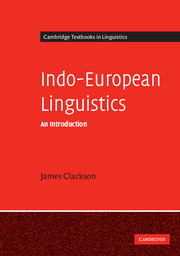Book contents
- Frontmatter
- Contents
- List of figures
- List of tables
- Preface
- Transliteration conventions
- 1 The Indo-European language family
- 2 Phonology
- 3 Morphophonology
- 4 Nominal morphology
- 5 Verbal morphology
- 6 Syntax
- 7 Lexicon and lexical semantics
- Glossary
- References
- Word index
- Language index
- Person index
- Subject index
Transliteration conventions
Published online by Cambridge University Press: 05 June 2012
- Frontmatter
- Contents
- List of figures
- List of tables
- Preface
- Transliteration conventions
- 1 The Indo-European language family
- 2 Phonology
- 3 Morphophonology
- 4 Nominal morphology
- 5 Verbal morphology
- 6 Syntax
- 7 Lexicon and lexical semantics
- Glossary
- References
- Word index
- Language index
- Person index
- Subject index
Summary
Words and texts cited in this book generally follow established conventions of transliteration or citation and are not given in IPA transcription. The following notes are intended to guide the reader to the pronunciation of forms cited in this book. Since in many cases the languages are no longer spoken, there is often uncertainty about the precise realisation of certain sounds, and the pronunciations given here can only at best be approximate. It should be noted that we have not attempted to give comprehensive accounts of the phonologies of the languages concerned, but merely to aid readers to understand how a particular sign is used. In general we have avoided giving details of signs which are not used in this book. Where no information is given on the pronunciation of a sign, the reader can assume that it has a value approximately equivalent to its IPA equivalent. In all cases we have tried to follow the standard orthography used in the scholarly literature, except in the case of Greek, for which we have not used the Greek alphabet, but a transliteration which should make it accessible to all and enable readers who know Greek to recognise the original words.
- Type
- Chapter
- Information
- Indo-European LinguisticsAn Introduction, pp. xiv - xxiiPublisher: Cambridge University PressPrint publication year: 2007



